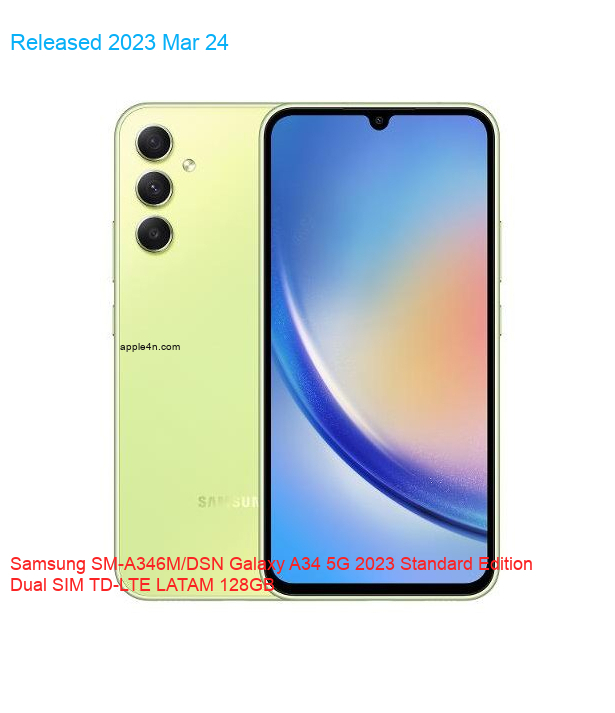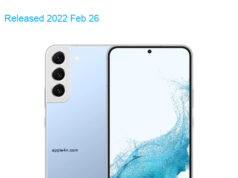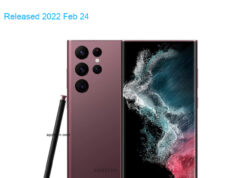| Brand | Samsung |
| Model | SM-A346M/DSN Galaxy A34 5G 2023 Standard Edition Dual SIM TD-LTE LATAM 128GB |
| Released | 2023 Mar 24 |
| Announced | 2023 Mar 14 |
| Hardware Designer | Samsung Electronics |
| Manufacturer | Samsung Electronics |
| Codename | Samsung A346 |
| OEM ID | A346MLVAZTO |
| General Extras | Haptic touch feedback |
| Device Category | Smartphone |
| Width | 78.1 mm |
| Height | 161.3 mm |
| Depth | 8.2 mm |
| Dimensions | 3.07×6.35×0.32 inches |
| Mass | 199 g |
| Platform | Android |
| Operating System | Google Android 13 (Tiramisu) |
| Software Extras | Voice Command , Navigation software , Face Recognition |
| CPU Clock | 2600 MHz |
| CPU | MediaTek Dimensity 1080 MT6877V/TTZA, 2022, 64 bit, octa-core, 6 nm, ARM Mail-G68 GPU |
| RAM Type | Yes |
| RAM Capacity (converted) | 6 GiB RAM |
| Non-volatile Memory Interface | UFS 3.1 |
| Non-volatile Memory Capacity (converted) | 128 GB ROM |
| Display Notch | 1-notch |
| Display Diagonal | 166.5 mm |
| Resolution | 1080×2340 |
| Horizontal Full Bezel Width | 8.33 mm |
| Display Area Utilization | 83.7% |
| Pixel Density | 393 PPI |
| Display Type | AM-OLED display |
| Display Subtype | Super AM-OLED |
| Number of Display Scales | 16.8M |
| Display Refresh Rate | 120 Hz |
| Scratch Resistant Screen | Gorilla Glass 5 |
| Graphical Controller | ARM Mali-G68MP4 |
| GPU Clock: | 800 MHz |
| A/V Out | No |
| Microphone(s) | stereo |
| Loudspeaker(s): | stereo |
| Audio Output: | USB Type-C |
| Supported Cellular Bands | GSM850 , GSM900 , GSM1800 , GSM1900 , UMTS2100 (B1) , UMTS1900 (B2) , UMTS1700/2100 (B4) , UMTS850 (B5) , UMTS900 (B8) , LTE2100 (B1) , LTE1900 (B2) , LTE1800 (B3) , LTE1700/2100 (B4) , LTE850 (B5) , LTE2600 (B7) , LTE900 (B8) , LTE700 (B12) , LTE700 (B13) , LTE700 (B17) , LTE800 (B20) , LTE850 (B26) , LTE700 (B28) , TD-LTE2600 (B38) , TD-LTE2300 (B40) , TD-LTE2500 (B41) , LTE1700/2100 (B66) , NR2100 (N1) , NR1800 (N3) , NR850 (N5) , NR2600 (N7) , NR900 (N8) , NR700 (N28) , TD-NR2300 (N40) , TD-NR2500 (N41) , NR1700/2100 (N66) , TD-NR3500 (N78) bands |
| Supported Cellular Data Links | GPRS , GPRS MSC33 , EDGE , EDGE MSC33 , UMTS , HSUPA , HSUPA 5.8 , HSDPA , HSPA+ 21.1 , DC-HSDPA 42.2 , LTE , LTE 100/50 , LTE 150/50 , LTE 300/50 , LTE 600/50 , LTE 1000/100 , NR 1500 , NR 2600 data links |
| SIM Card Slot | Nano-SIM (4FF) |
| Complementary Phone Services | Voice transmission , Voice speaker , Vibrate , Speakerphone , ANC , HD Voice , VoLTE |
| SAR (head) | 0.750 W/kg |
| SAR (body) | 0.760 W/kg |
| Dual Cellular Network Operation | Dual standby |
| Sec. Supported Cellular Networks: | GSM850 , GSM900 , GSM1800 , GSM1900 , UMTS2100 (B1) , UMTS1900 (B2) , UMTS1700/2100 (B4) , UMTS850 (B5) , UMTS900 (B8) , LTE2100 (B1) , LTE1900 (B2) , LTE1800 (B3) , LTE1700/2100 (B4) , LTE850 (B5) , LTE2600 (B7) , LTE900 (B8) , LTE700 (B12) , LTE700 (B13) , LTE700 (B17) , LTE800 (B20) , LTE850 (B26) , LTE700 (B28) , TD-LTE2600 (B38) , TD-LTE2300 (B40) , TD-LTE2500 (B41) , LTE1700/2100 (B66) , NR2100 (N1) , NR1800 (N3) , NR850 (N5) , NR2600 (N7) , NR900 (N8) , NR700 (N28) , TD-NR2300 (N40) , TD-NR2500 (N41) , NR1700/2100 (N66) , TD-NR3500 (N78) |
| Sec. Supported Cellular Data Links: | GPRS , GPRS MSC33 , EDGE , EDGE MSC33 , UMTS , HSUPA , HSUPA 5.8 , HSDPA , HSPA+ 21.1 , DC-HSDPA 42.2 , LTE , LTE 100/50 , LTE 150/50 , LTE 300/50 , LTE 600/50 , LTE 1000/100 , NR 1500 , NR 2600 |
| Sec. SIM Card Slot | Nano-SIM (4FF) |
| Touchscreen Type | Capacitive multi-touch screen |
| Expansion Interfaces | TransFlash , microSD , microSDHC , microSDXC |
| USB | USB 2.0 |
| USB Services | USB charging , USB fast charging , USB Host , USB OTG 1.3 , USB PD , USB PD 2.0 |
| USB Connector | USB C reversible |
| Max. Charging Power | 25.0 W |
| Bluetooth | Bluetooth 5.3 |
| Wireless LAN | 802.11a , 802.11b , 802.11g , 802.11n , 802.11ac |
| Wireless Services | Wi-Fi Direct , Wi-Fi Tethering |
| NFC | NFC A , NFC B |
| FM Radio Receiver | No |
| Complementary Satellite Services | Simultaneous GPS , A-GPS , Geotagging , QuickGPS |
| Supported GLONASS protocol(s) | L1OF |
| Supported Galileo service(s) | E1 |
| Supported BeiDou system (BDS) | B1I BeiDou receiver |
| Camera Placement | Rear |
| Camera Image Sensor | BSI CMOS |
| Image Sensor Pixel Size | 0.80 micrometer |
| Number of effective pixels | 48.0 MP camera |
| Aperture (W) | f/1.80 |
| Zoom | 1.0 x optical zoom |
| Focus | PD AF |
| Video Recording | 3840×2160 pixel |
| Flash | single LED |
| Camera Extra Functions | EIS (video) , OIS , OIS (video) , Pixel unification , HDR photo , Red-eye reduction , Slow motion video , Burst mode , Touch focus , Panorama Photo , Face detection , Face tagging , Smile detection , Face retouch |
| Aux. Camera Image Sensor | BSI CMOS |
| Aux. Cam. Image Sensor Pixel Size | 1.12 micrometer |
| Aux. Camera Number of Pixels | 8.0 MP aux. cam |
| Aux. Camera Aperture (W) | f/2.20 |
| Aux. Camera Extra Functions | HDR photo , Burst mode , Panorama Photo , Face detection , Face tagging , Smile detection |
| Aux. 2 Camera Image Sensor | BSI CMOS |
| Aux. 2 Camera Number of Pixels | 4.9 MP aux. 2 cam |
| Aux. 2 Camera Aperture (W) | f/2.40 |
| Aux. 3 Camera Image Sensor | No |
| Aux. 4 Camera Image Sensor | No |
| Secondary Camera Placement | Front |
| Secondary Camera Sensor | BSI CMOS |
| Secondary Camera Number of pixels | 13.0 MP sec. cam |
| Secondary Aperture (W) | f/2.20 |
| Secondary Video Recording | 3840×2160 pixel |
| Secondary Camera Extra Functions | HDR photo , Burst mode , Panorama Photo , Face detection , Face tagging , Smile detection , Face retouch , Face retouch (video) |
| Sec. Aux. Cam. Image Sensor | No |
| Built-in compass | Yes |
| Built-in accelerometer | 3D accelerometer |
| Built-in gyroscope | Yes |
| Additional sensors | In-screen FP sensor , Hall , L sensor , P sensor , Step counter |
| Protection from solid materials | 6 Totally protected from dust |
| Protection from liquids | 7 Protected against immersion up to 1m of depth |
| Immersion into liquids (depth limit) | 100 cm |
| Immersion into liquids time limit | 30 min |
| Battery | Li-ion |
| Nominal Battery Voltage | 3.87 Volts |
| Nominal Battery Capacity | 5000 mAh battery |
| Nominal Battery Energy | 19.35 Wh |
| Estimated Battery Life | 22.0 hours |
| Talk Time: | 35.0 hours |
| Market Countries | Brazil , Chile , Colombia , Costa Rica , Ecuador , Guatemala , Honduras , Nicaragua , Panama , Paraguay |
| Market Regions | Central America , South America |
| Price | 519.80 USD |
| Added | 2025-02-08 |
Specifications data description of this 📱Samsung SM-A346M/DSN Galaxy A34 5G 2023 Standard Edition Dual SIM TD-LTE LATAM 128GB📱
Title: Samsung SM-A346M/DSN Galaxy A34 5G 2023 Standard Edition Dual SIM TD-LTE LATAM 128GB: A Comprehensive Specification Guide
Introduction
————
The Samsung SM-A346M/DSN Galaxy A34 5G 2023 Standard Edition Dual SIM TD-LTE LATAM 128GB is a powerful and versatile device that offers users a top-notch smartphone experience. With its advanced features and sleek design, the Galaxy A34 is a great choice for anyone looking for a reliable and high-performing device. In this post, we’ll take a closer look at the specifications of the Galaxy A34 and what makes it stand out in the crowded smartphone market.
Lineup
——
The Samsung Galaxy A34 is part of the company’s popular A-series of smartphones, which are known for their premium features and affordability. The A-series includes a range of devices, from budget-friendly options to high-end flagships, making it a great choice for users with different needs and budgets.
Design
——
The Galaxy A34 has a sleek and modern design, with a glass front and a sturdy plastic back. The device is available in a range of colors, allowing users to choose the one that best suits their style. The A34 has a 6.7-inch Super AMOLED display with a resolution of 1080 x 2400 pixels and a refresh rate of 120Hz, making it perfect for watching videos, playing games, and browsing the web.
Specifications
————–
Here are the key specifications of the Samsung SM-A346M/DSN Galaxy A34 5G 2023 Standard Edition Dual SIM TD-LTE LATAM 128GB:
🌐 **NETWORK**: The A34 supports 5G and TD-LTE networks, providing fast and reliable connectivity.
📅 **LAUNCH**: The device was launched in 2023.
🏋️ **BODY**: The A34 has a dimensions of 163.7 x 76.1 x 8.1 mm and weighs 195 g.
🌈 **DISPLAY**: The device has a Super AMOLED display with a resolution of 1080 x 2400 pixels and a 20:9 aspect ratio.
🤖 **OS**: The A34 runs on Android 13 with One UI 5.0.
🛠️ **Chipset**: The device is powered by the Exynos 2300 chipset.
💪 **CPU**: The A34 has an octa-core (2×2.2 GHz Cortex-A78 & 6×2.0 GHz Cortex-A55) processor.
🖥️ **GPU**: The device has a Mali-G79 MP18 GPU.
🎮 **GPU**: The A34 has an Adreno 730 GPU.
🧠 **MEMORY**: The device has 128GB of internal storage and 8GB of RAM.
📷 **CAMERA**: The device has a 64 MP (wide) + 12 MP (ultrawide) + 5 MP (depth) rear camera and a 32 MP (wide) front camera.
🔈 **SOUND**: The A34 has a stereo speaker system and supports Dolby Atmos.
📡 **COMMS**: The device supports Wi-Fi 802.11 a/b/g/n/ac/6e, Bluetooth 5.3, GPS, NFC, and a USB Type-C 2.0 port.
💡 **FEATURES**: The A34 has a range of features, including an under-display fingerprint sensor, face recognition, and IP67 water and dust resistance.
🔋 **BATTERY**: The device has a 5000 mAh battery and supports fast charging.
Conclusion
———-
The Samsung SM-A346M/DSN Galaxy A34 5G 2023 Standard Edition Dual SIM TD-LTE LATAM 128GB is a powerful and feature-packed device that offers users a great smartphone experience. With its fast 5G connectivity, high-performing chipset, and impressive cameras, the Galaxy A34 is a great choice for anyone looking for a reliable and versatile device. We hope this post has given you a better understanding of the specifications of the Galaxy A34 and what makes it a great device.
We would love to hear your thoughts on the Galaxy A34, so please leave a comment below and let us know what you think.








